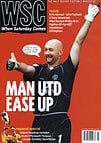 Steve Field appreciates of I See It All by Gil Merrick, the former Birmingham City and England goalkeeper
Steve Field appreciates of I See It All by Gil Merrick, the former Birmingham City and England goalkeeper
This book has a curiously casual approach to games and events long since regarded as seminal. You would expect some acknowledgment that 23 England appearances in goal – all between 1952 and 1954 – was, for a Second Division player, rather an unusual record. Or that setting up the Nat Lofthouse strike which confirmed the “Lion of Vienna” legend was a notable achievement, or even that the 6-3 Wembley defeat against Hungary in 1953 actually took place. The explanation probably lies somewhere between Gilbert Merrick’s famed coolness and a clearly hurried printing deadline hot on the heels of the World Cup campaign which ended his international career.
Stylistically, it’s a gem. Although I would be surprised if Merrick actually wrote it, it reads as though he might have done. It lacks pretension and, mercifully, the stereotyping of foreigners typical of Fifties football autobiographies. Only in the section on that ill-fated Switzerland tournament is self-justification allowed to intrude. For the most part it’s all hearty stuff, solid workmanship leavened by occasional moments of quaintness. The days when professionals, if they were wise, maintained a career outside the game (Merrick was a schoolmaster) seem a long way off now. So too do woollen England jerseys which had to be handed back after the match – “they were a trophy more rare than an FA Cup winner’s medal” – and whose heavy shoulder seams sagged to the wrists in wet weather.
While Merrick’s opinions are invariably mildly expressed, they convey an accurate picture both of his era and of the keeper’s unique position. Of floodlit matches, then a novelty, he grumbles: “It was almost like playing on one’s own, with nothing but darkness beyond the lights.” About exhibition games, he observes pettily: “The goalkeeper suffers most, looking silly under a hatful of goals.” White plastic balls, meanwhile, are dismissed as “swervy”.
A whole chapter is devoted to one-club professionals and how to reward them – Merrick himself played predominantly for Birmingham City and was later their manager – and while some of the issues lack lustre in post-maximum wage days, others, like the call for full-time referees, are distressingly perennial. Not least of these – and one of the book’s two timeless themes – is the tension between “English” and “Continental” styles of play.
The other is goalkeeping. Quite half of the book is devoted to methods and techniques, and while this is probably the part most readers will skip, it is in fact very informative. In all the detail you would expect from a teacher, Merrick instructs readers in such topics as Shooting, Conditions, Clearing One’s Lines, Passing Back, Corners, Free Kicks, Penalties and Training. In a genre usually notable for self-advertisement such practical advice is refreshing. While a goalkeeper no longer needs to beware of being charged or bundled into the net along with the ball, he still needs to see the danger of low corners, to be brave and to avoid turning his back.
Tellingly, Merrick describes not opposing forwards but their respective shooting methods – unexpected (Lofthouse), predatorial (Arthur Rowley), versatile (Len Shackleton) and dangerous (Trevor Ford). He rates John Charles and Jimmy Hagan as the best. The only foreigners singled out are Spain’s Ladislao Kubala and, surprisingly, Julio Pérez of Uruguay, whom he encountered in a 1953 friendly, but not in England’s 4-2 World Cup quarter-final defeat, Merrick’s final international.
While that game was undoubtedly his personal nemesis, the open wound in English football in 1954 was the double trouncing by Hungary. While the Wembley game of the previous year doesn’t get a mention, the 7-1 defeat in Budapest does, and the subtext of the international sections of the book is clear enough.
At the time it was becoming accepted that something was badly wrong with English tactics. Merrick is torn between awareness of the problem and (endearingly) an urge to forget the goals he’s conceded through no fault of his own. He appreciates the fluidity which enabled Kocsis and Puskas to expose England on the break from behind the offside trap and recongnises that, although the English were far fitter, the Hungarians were quicker over short distances. “Ball work and sprinting must be the basis of their training,” he concludes.
The World Cup in Switzerland also provides food for thought. Top foreign teams achieve success by playing the ball short, on the ground, with a telling through ball for deep-lying forwards. “A contrast indeed,” he says, “to football as we know it in this country.”
In the end, then, Gil Merrick did see it all – from a position of impotence and too late to prevent Bert Williams taking his England place. I’d like to think there’s a little joke in that title somewhere.
From WSC 169 March 2001. What was happening this month